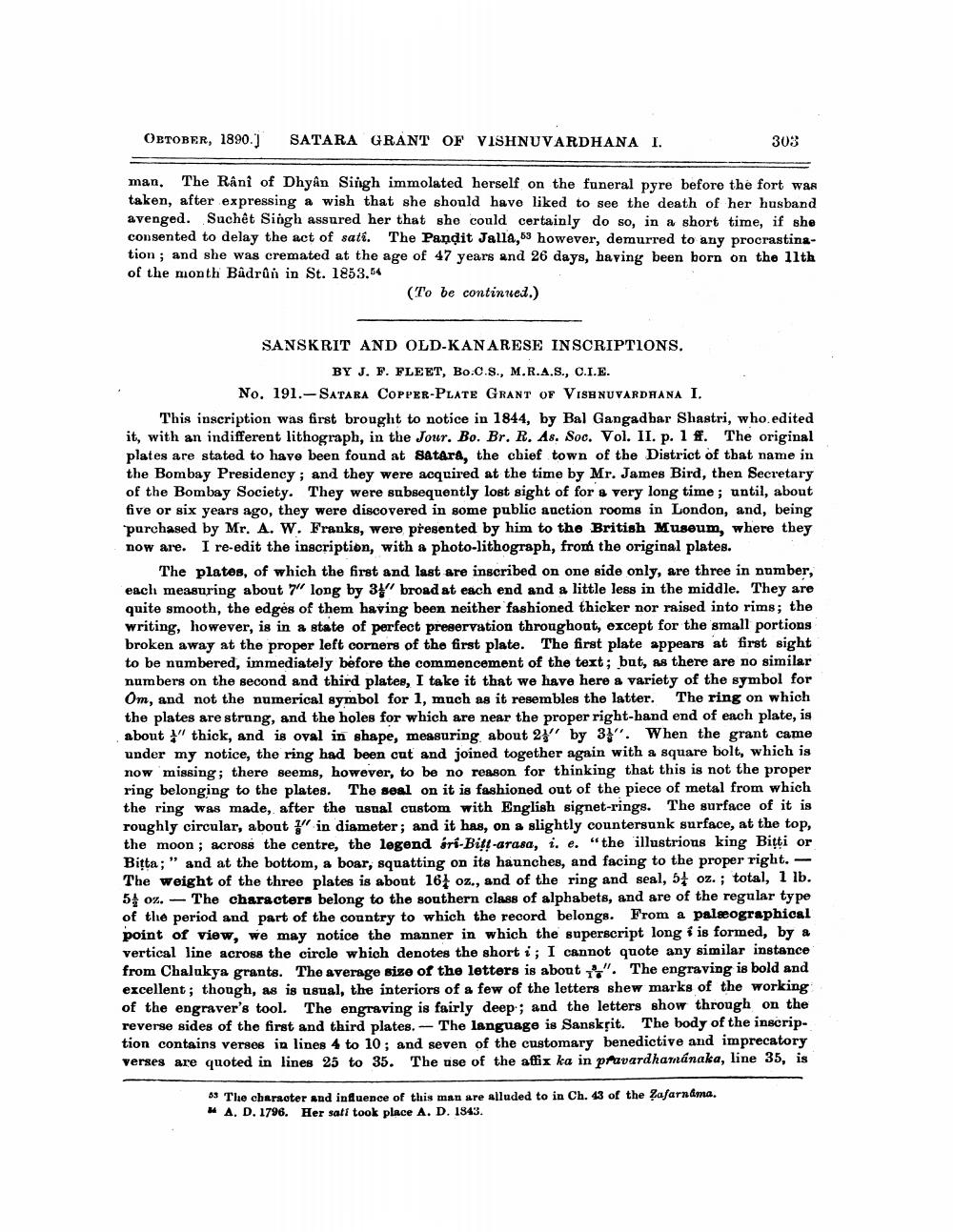________________
OBTOBER, 1890.)
SATARA GRANT OF VISHNUVARDHANA I.
303
man. The Râni of Dhyan Singh immolated herself on the funeral pyre before the fort was taken, after expressing a wish that she should have liked to see the death of her husband avenged. Suchet Singh assured her that she could certainly do so, in a short time, if she consented to delay the act of sati. The Pandit Jalla,63 however, demurred to any procrastination; and she was cremated at the age of 47 years and 26 days, having been born on the 11th of the month Bådrûn in St. 1853.54
(To be continued.)
SANSKRIT AND OLD-KANARESE INSCRIPTIONS.
BY J. F. FLEET, Bo.C.S., M.R.A.S., C.I.E. No. 191.- SATARA COPPER-Plate GRANT OF VISHNUVARDHANA I. This inscription was first brought to notice in 1844, by Bal Gangadbar Shastri, who edited it, with an indifferent lithograph, in the Jour. Bo. Br. R. As. Soc. Vol. II. p. 1 f. The original plates are stated to have been found at Satara, the chief town of the District of that name in the Bombay Presidency; and they were acquired at the time by Mr. James Bird, then Secretary of the Bombay Society. They were subsequently lost sight of for a very long time; until, about five or six years ago, they were discovered in some public auction rooms in London, and, being purchased by Mr. A. W. Franks, were presented by him to the British Museum, where they now are. I re-edit the inscription, with a photo-lithograph, from the original plates.
The plates, of which the first and last are inscribed on one side only, are three in number, each measuring about 7" long by 3\"broad at each end and a little less in the middle. They are quite smooth, the edges of them having been neither fashioned thicker nor raised into rims; the writing, however, is in a state of perfect preservation throughout, except for the small portions broken away at the proper left corners of the first plate. The first plate appears at first sight to be numbered, immediately before the commencement of the text; but, as there are no similar numbers on the second and third plates, I take it that we have here a variety of the symbol for Om, and not the numerical symbol for 1, much as it resembles the latter. The ring on which the plates are strong, and the holes for which are near the proper right-hand end of each plate, is about " thick, and is oval in shape, measuring, about 2} by 3". When the grant came under my notice, the ring had been cut and joined together again with a square bolt, which is now missing; there seems, however, to be no reason for thinking that this is not the proper ring belonging to the plates. The seal on it is fashioned out of the piece of metal from which the ring was made, after the usual custom with English signet-rings. The surface of it is roughly circular, about " in diameter; and it has, on a slightly countersunk surface, at the top, the moon ; across the centre, the legend sri-Bitt-arasa, i. e. "the illustrious king Bitti or Bitta;" and at the bottom, a boar, squatting on its haunches, and facing to the proper right. - The weight of the three plates is about 164 oz., and of the ring and seal, 5 oz. ; total, 1 lb. 54 02. - The characters belong to the southern class of alphabets, and are of the regular type of the period and part of the country to which the record belongs. From a paleographical point of view, we may notice the manner in which the superscript long i is formed, by a vertical line across the circle which denotes the short i ; I cannot quote any similar instance from Chalukya grants. The average size of the letters is about 1". The engraving is bold and excellent; though, as is usual, the interiors of a few of the letters shew marks of the working of the engraver's tool. The engraving is fairly deep; and the letters show through on the reverse sides of the first and third plates. The language is Sanskrit. The body of the inscription contains verses in lines 4 to 10, and seven of the customary benedictive and imprecatory verses are quoted in lines 25 to 35. The use of the affix ka in pravardhamánaka, line 35, is
03 The character and influence of this man are alluded to in Ch. 43 of the Zafarnama.
A. D. 1796. Her sati took place A. D. 1843.




